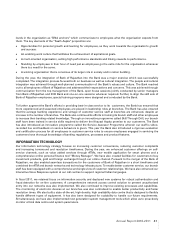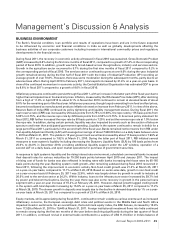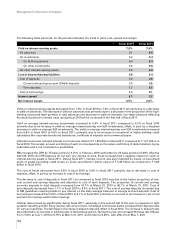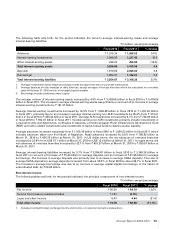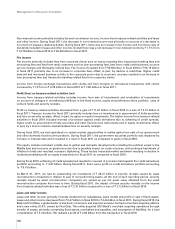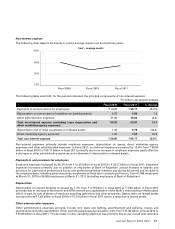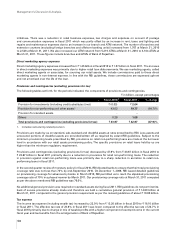ICICI Bank 2011 Annual Report Download - page 52
Download and view the complete annual report
Please find page 52 of the 2011 ICICI Bank annual report below. You can navigate through the pages in the report by either clicking on the pages listed below, or by using the keyword search tool below to find specific information within the annual report.
payments during the nine months of fiscal 2011. The rupee appreciated by 1.1% against the US dollar from ` 45.14 per
US dollar at March 31, 2010 to ` 44.65 per US dollar at March 31, 2011.
Tight liquidity and the rising interest rate environment combined with the impact of regulatory changes, led to lower
mobilisation under savings and investment products during fiscal 2011. First year retail premium underwritten in the
life insurance sector decreased by 8.5% (on weighted received premium basis) to ` 503.68 billion in fiscal 2011 from
` 550.24 billion in fiscal 2010. The average assets under management of mutual funds decreased by 6.3% from `
7,475.25 billion in March 2010 to ` 7,005.38 billion in March 2011. However, gross premium of the non-life insurance
sector (excluding specialised insurance institutions) grew by 21.7% to ` 425.69 billion in fiscal 2011.
There were a number of key regulatory developments in the Indian financial sector during fiscal 2011:
•In December 2010, RBI imposed a regulatory ceiling on the loan-to-value ratio in respect of housing loans at 80%.
However, small value loans of less than ` 2.0 million were permitted to have a loan to value ratio not exceeding
90%. Further, the risk weight for residential loans of ` 7.5 million and above was set at 125% irrespective of the
loan to value ratio, as against the earlier mandated 100% for a loan to value ratio of above 75%. With respect to
loans outstanding under special housing loan products with lower interest rates in initial years, the standard asset
provisioning was increased from 0.4% to 2.0%.
•In February 2011, RBI issued guidelines declassifying loans sanctioned to non-banking finance companies
(NBFCs) for on-lending to individuals and entities against gold jewellery as direct agriculture lending under priority
sector requirements. Similarly, investments made by banks in securitised assets originated by NBFCs, where the
underlying assets were loans against gold jewellery and purchase/assignment of gold loan portfolio from NBFCs
were also made ineligible for classification under agriculture sector lending.
•RBI advised banks to henceforth not issue Tier-1 and Tier-2 capital instruments with step-up options so that these
instruments remain eligible for inclusion in the new definition of regulatory capital under the Basel III framework.
•In the Union Budget for fiscal 2012, the government enhanced priority sector eligibility ceiling for housing loans for
dwelling units from ` 2.0 million to ` 2.5 million.
•In May 2010, RBI permitted infrastructure NBFCs to avail of external commercial borrowings for on-lending to
the infrastructure sector. Further, in July 2010, guidelines were issued to permit take-out financing arrangement
through the external commercial borrowing route for refinancing of rupee loans availed for financing infrastructure
projects particularly in the areas of seaports, airports, roads and power. In the Union Budget for fiscal 2012, the
limit for investment by Foreign Institutional Investors (FIIs) in corporate bonds with residual maturity of over five
years issued by companies in infrastructure sector, was raised by US$ 20 billion, taking the limit to US$ 25 billion.
Further, it was also proposed to create special vehicles in the form of notified infrastructure debt funds with lower
withholding tax on their interest payments and tax exemptions on their incomes.
•In August 2010, the RBI issued a discussion paper on entry of new banks in the private sector. In January 2011, RBI
also released a discussion paper on the presence of foreign banks in India.
•In June 2010, the Insurance Regulatory and Development Authority (IRDA) introduced revisions to the regulations
governing unit linked insurance products such as increase in the lock-in period from three years to five years,
increase in minimum mortality cover, cap on surrender and other charges and minimum guaranteed return on
pension annuity products.
•In March 2011, IRDA conducted an audit of the third party motor insurance pool and concluded that the
pool reserves needed to be enhanced significantly. Accordingly, IRDA stipulated that all general insurance
companies should increase these reserves based on a provisional loss ratio of 153% for the pool for all years
commencing from the year ended March 31, 2008, with the final loss ratio to be determined through a further
review in fiscal 2012.
Introduction of Base Rate system
Historically, interest rates on loans extended by banks were linked to the prime lending rate (PLR) of each bank. With
effect from July 1, 2010, RBI implemented a new base rate mechanism, requiring each bank to set and publicly disclose
its minimum rate or “Base Rate” for all new loans and advances and renewal of existing facilities, subject to certain
limited exceptions. While existing loans based on the Benchmark Prime Lending Rate (BPLR) system would continue
Management’s Discussion & Analysis
50



